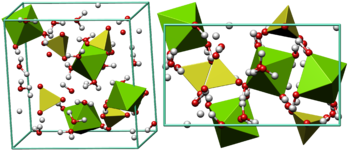Epsomite
| Epsomite | ||
|---|---|---|
2V angle Measured: 52° | | |
| Solubility | In water | |
| Alters to | Dehydrates in dry air | |
| References | [2][3][4] | |
Epsomite, Epsom salt, or magnesium sulfate heptahydrate, is a
hydrous magnesium sulfate
mineral with formula MgSO4·7H2O.
Epsomite crystallizes in the
specific gravity
of 1.67.
It is readily soluble in water. It absorbs water from the air and converts to hexahydrate with the loss of one water molecule and a switch to
monoclinic
structure.
Etymology
It was first systematically described in 1806 for an occurrence near Epsom, Surrey, England, after which it was named.
Discovery and occurrence
Epsomite forms as
volcanic fumarole deposits, and as rare beds in evaporite layers such as those found in certain bodies of salt water.[5] It occurs in association with melanterite, gypsum, halotrichite, pickeringite, alunogen, rozenite and mirabilite.[4]
Related minerals
The epsomite group includes solid solution series with morenosite (NiSO₄·7H₂O) and goslarite (ZnSO₄·7H₂O).[3]

Research
Research on topical magnesium (for example Epsom salt baths) is very limited.[6] The Epsom Salt Council recommends bathing 2 or 3 times/week, using 500–600 g (18–21 oz) Epsom salts each time.[7]
Uses
Epsom salt is commonly sold as the main ingredient in
glycerin (used as a humectant) and fragrances. The purpose of bath salts is mostly to make the bathing experience more enjoyable and serve as a vehicle for cosmetics, though they are said to improve cleaning and aid in exfoliation.[8]
See also
References
- S2CID 235729616.
- ^ Webmineral data
- ^ a b Mindat.org
- ^ a b Handbook of Mineralogy
- OCLC 84152915.
- ^ Rath, Linda. "Why Take an Epsom Salts Bath?". WebMD.
- ^ https://www.epsomsaltcouncil.org/wp-content/uploads/2015/10/report_on_absorption_of_magnesium_sulfate.pdf
- OCLC 42598586.
